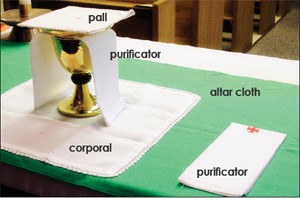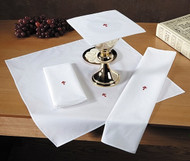The Significance of Linens and Vestments in the Catholic Church
Jul 2nd 2024
In the rich tapestry of Catholic tradition, linens and vestments hold profound symbolic and functional significance. They are more than mere fabrics; they embody centuries of tradition, theology, and reverence. Understanding their role provides deeper insights into the liturgical practices and the spirituality of the Catholic Church.
Liturgical Linens: Sacred Cloths of the Altar
Liturgical linens are essential to the celebration of the Eucharist, the heart of Catholic worship. Each piece of linen has a specific purpose and is treated with utmost care and reverence.
- The Corporal: This square linen cloth is placed on the altar during the Mass. The Eucharistic elements—the bread and wine—are placed on it, symbolizing the purity and sanctity required for the sacred mysteries. The corporal ensures that any fragments of the consecrated host are caught and respected, underscoring the belief in the real presence of Christ in the Eucharist.
- The Purificator: A small linen cloth used to cleanse the chalice and paten after Communion. It sign
 ifies the purity required in the vessels that hold the Body and Blood of Christ and reflects the reverence with which the Eucharist is treated.
ifies the purity required in the vessels that hold the Body and Blood of Christ and reflects the reverence with which the Eucharist is treated. - The Pall: A stiffened square cloth used to cover the chalice. It symbolizes the protection of the sacred contents of the chalice and prevents any foreign objects from contaminating the consecrated wine.
- The Lavabo Towel: Used by the priest to dry his hands during the ritual washing (lavabo), it signifies the inner purity and cleanliness needed to handle the Eucharist.
Vestments: Garments of Service and Symbolism
Vestments are the liturgical garments worn by clergy during Mass and other sacraments. Each piece carries deep symbolic meanings and historical significance.
- The Alb: A long white robe worn by all liturgical ministers, symbolizing baptismal purity and the new life in Christ. Its whiteness reflects the joy and resurrection of Easter.
- The Stole: A long, narrow strip of cloth worn around the neck by priests and deacons. For priests, it hangs straight down, while deacons wear it diagonally. The stole represents the yoke of Christ and the authority and responsibility of ordained ministry.
- The Chasuble: The outermost garment worn by the priest during the Mass. Its flowing design symbolizes the charity and love that should cloak all Christian actions. The chasuble's color changes with the liturgical seasons, reflecting different aspects of the Christian mystery—white for celebration, red for martyrdom, green for ordinary time, and purple for penitence.
- The Cincture: A cord tied around the waist over the alb. It symbolizes chastity and the readiness to serve, echoing the scriptural call to gird one’s loins in preparation for the Lord’s work.
- The Cope: A long cloak-like vestment worn during processions and non-Eucharistic liturgical functions. It signifies the priest’s role as a shepherd guiding the faithful.
Theological and Spiritual Dimensions
The use of linens and vestments is deeply rooted in Catholic theology and spirituality. They serve as tangible expressions of intangible truths. The care and reverence given to these items reflect the sacredness of the liturgy and the belief in the real presence of Christ. By maintaining these traditions, the Church connects the faithful with the continuity of worship throughout the ages.
Moreover, the linens and vestments act as visual catechesis. They teach and remind the faithful of the sacred mysteries being celebrated. The intricate designs, colors, and uses of these items invite deeper reflection on the life, death, and resurrection of Jesus Christ and the call to live a life of holiness.
Conclusion
In the Catholic Church, linens and vestments are far more than functional items; they are integral to the expression of faith and worship. Their careful use and maintenance reflect the profound reverence for the sacred mysteries of the faith. By understanding their significance, the faithful can deepen their appreciation for the rich liturgical traditions of the Church and the timeless truths they embody.

